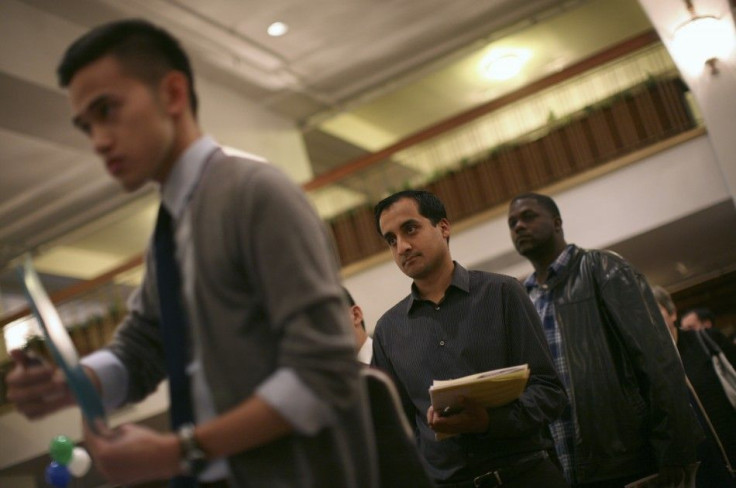U.S. Jobless Claims Falls to Nearly 4-Yr Low

(REUTERS) -- The number of Americans filing for new jobless benefits dropped to an almost four-year low last week, and factory activity in the mid-Atlantic expanded moderately, suggesting the economy carried some momentum into the new year.
But the pace of growth probably will slow. Analysts cautioned the drop in jobless claims likely was exaggerated by seasonal factors, and the slow pace of new orders in the factory report along with a drop in new home building and permits in December showed that obstacles to a strong recovery remain.
Still, the employment and factory data added to a rash of stronger-than-expected economic signals, with growth in the fourth quarter forecast at an annual pace of about 3 percent - a step up from the prior quarter's 1.8 percent rate.
It's not a robust picture, but it's certainly an improving picture and one that you hope sets up some improvement over the longer term in consumption, said Brian Levitt, an economist at OppenheimerFunds in New York.
Initial claims for state unemployment benefits fell 50,000 to a seasonally adjusted 352,000 last week, the lowest level since April 2008, the Labor Department said.
The week also marked the largest drop in applications since September 2005 and took claims within spitting distance of the 350,000 mark that economists say would signal strong job growth.
The claims data covered the period when surveys are conducted for the government's January payrolls report, and claims dropped by 14,000 between the December and January survey periods.
But claims tend to be volatile around this time of year. The four-week moving average of claims, considered to be a better measure of labor market trends, fell 3,500 to 379,000 last week. It has held below 400,000 for 10 straight weeks.
The initial indications for the jobs report in January are encouraging and suggest that we will see another 200,000-plus reading on private payrolls for the month, said John Ryding, chief economist at RDQ Economics in New York.
Nonfarm payrolls increased 200,000 in December, with the unemployment rate dropping to a near three-year low of 8.5 percent.
Separately, the Philadelphia Federal Reserve Bank reported its business activity index rose to 7.3 from 6.8 in December. A reading above zero indicates expansion in the mid-Atlantic region's manufacturing sector.
But new orders and shipments slowed, taking some shine off the report. In addition, unfilled orders and delivery time fell, indicating factory activity in the region could slow in the months ahead.
The region's employment picture improved, however, with factories adding more workers and extending hours for existing employees.
The data and strong demand at European bond auctions, which helped to ease some concerns about Europe's debt crisis, propelled U.S. stocks higher. The Standard & Poor's 500 index rose for a third straight day.
U.S. Treasury debt lost some of its safe-haven appeal, sending prices tumbling. The dollar fell to a two-week low against the euro.
HOUSING MIXED
Other data showed housing starts fell 4.1 percent to a seasonally adjusted annual rate of 657,000 units in December. The decline came from the volatile multi-family segment, which plunged 20.4 percent.
Starts of single family houses - which account for a larger share of new home construction - rose 4.4 percent, adding to views that the housing market decline has bottomed and home construction will contribute to economic growth this year.
Permits for future home construction eased slightly.
There are too many distressed homes on the market in the largest home building areas for starts to rise sharply, said Joel Naroff, chief economist at Naroff Economic Advisors in Holland, Pennsylvania. Still, a recovery is under way and means housing will be adding to growth going forward.
The continued stream of relatively better economic data could further temper expectations among some economists that the Federal Reserve could launch a fresh round of bond buying to spur the recovery.
The Fed meets next week and no policy action is expected, although the central bank may signal it will keep overnight rates pressed to zero for longer than had previously been expected.
With inflation showing little signs of life, unemployment too high and Europe's debt troubles still a threat to the economy, analysts say a further Fed easing cannot be ruled out.
INFLATION STILL MUTED
The Consumer Price Index was unchanged in December for a second straight month. Core CPI, which excludes more volatile food and energy costs, inched up 0.1 percent after rising 0.2 percent in November.
If inflation continues to moderate, it definitely opens the door for additional quantitative easing by the Fed, said Ryan Sweet, a senior economist at Moody's Analytics in West Chester Pennsylvania.
The Fed has already bought $2.3 trillion worth of bonds to keep borrowing costs low and stimulate the economy.
In December, overall inflation was held back by gasoline prices, which fell for a third month in a row. Food prices rose modestly. Overall consumer prices rose 3 percent last year after increasing 3.4 percent in November from a year earlier.
Core consumer prices last month were dampened by new motor vehicle costs, which fell for a third straight month, while used cars and truck prices dropped for the fourth successive month.
Clothing prices slipped, indicating discounting by retailers to attract holiday shoppers. But housing costs held up, reflecting the rising demand for rental apartments as the weak housing market pushes Americans away from home ownership.
In the 12 months to December, core CPI increased 2.2 percent after rising by the same margin in November. That follows a record low of 0.6 percent in October.
The Fed would like to see core inflation at 2 percent or a little less, although the price measure its follows most closely tends to run below the core CPI.
© Copyright Thomson Reuters 2024. All rights reserved.












